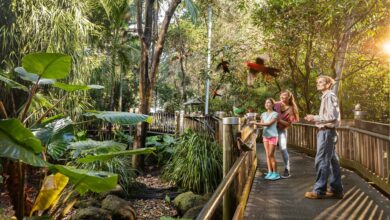
Special cradles are protecting the boughs of one of Queens Park’s most impressive heritage trees.
Ipswich City Council has recently taken proactive measures to help ensure the longevity of this important Queensland native tree.
Padded support cradles have been installed underneath three of the tree’s particularly long limbs that are susceptible to leverage fracture in strong winds.
Council worked with Heritage Tree Care to ensure this healthy and historic tree was set up well to cope for the future.
Arboricultural Coordinator Wendy Collier said the support cradles would not be firm on the boughs, but would assist with over-extension when wind velocity forced bough movement beyond their structural limitations.
“This movement is essential in the tree and needs to be independent to maintain and encourage reactive wood and future strength,” she said.
“Lowering of the cradle will occur every few years, ensuring free bough movement to assist with overall limb intensity.”
Works, Parks and Recreation Acting Chief Operating Officer Bryce Hines said if one of the extended limbs was to fracture it could jeopardise the future health of this tree.
“With storm season approaching it’s timely to make sure this very old and significant tree has some extra assistance,” he said.







Queens Park’s Hills Weeping Figs
The Hill’s Weeping Fig (Ficus microcarpa var. hillii) was named after Walter Hill, who was also the first Colonial Botanist of Queensland and first Superintendent of the Brisbane Botanic Gardens. He donated some of Queens Park’s early trees and shrubs.
Many of Queens Park’s Hill’s Weeping Figs were planted because they were a favourite tree of one of the park’s early curators, Frederick Turley. He personally planted many of the trees in many of the parks and avenues in Ipswich.


4
4.5